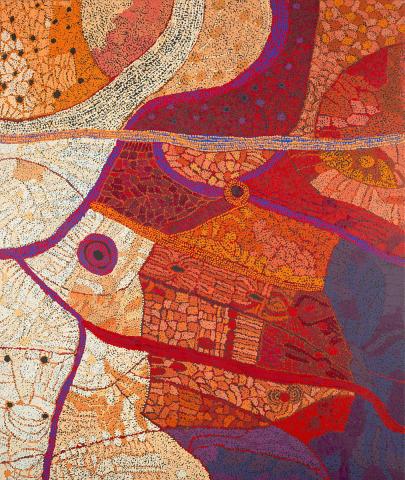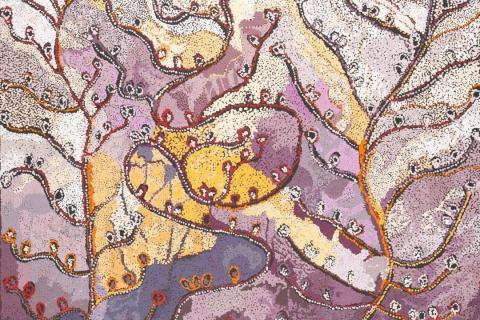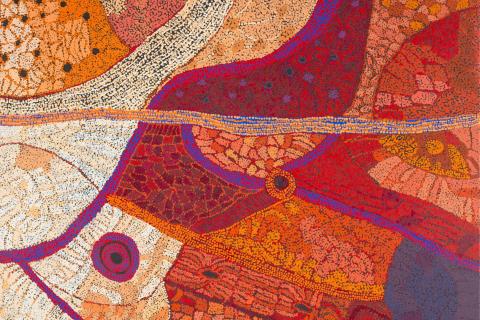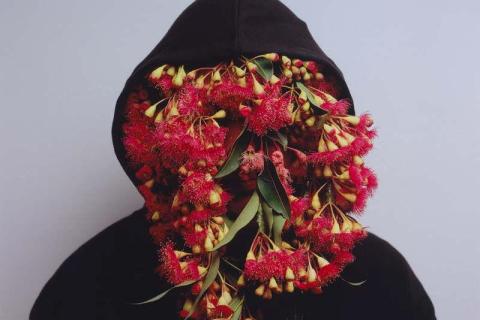Mapping Country
‘Seeds and Sovereignty’
Mapping Country
The establishment of missions and settlements throughout Australia ruptured traditional ecological systems. However, even when displaced from their homelands, responsibility to land and sustainability remains an imperative for many Aboriginal people. Artists commonly use their work to express connection to and authority over their Country. Such depictions are often maps of Country — literal, codified or even metaphysical — featuring plants that signify abundance or location.
Alec Baker’s Ngura (Country) and Betty Chimney’s Ngayuku Ngura (My Country) employ classic Western Desert topographical mapping designs embedded with ancestral stories, significant sites, iconography and landmarks, including plants.
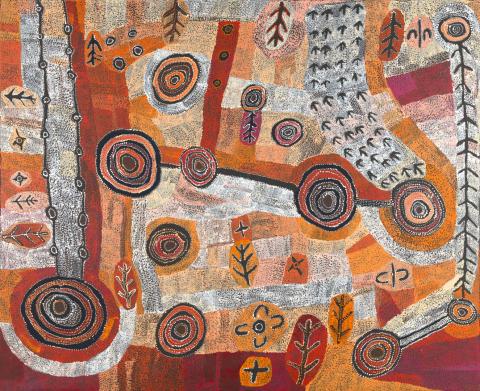
Ngura (Country) 2018
- BAKER, Alec - Creator

Skin Country 2018
- McGREGOR, Carol - Creator
Feature image: Yankuntjatjara artist Betty Chimney’s Ngayuku Ngura (My Country) (detail) 2018 / Purchased 2018. Queensland Art Gallery | Gallery of Modern Art Foundation / © Betty Chimney/Copyright Agency
Similarly, Carol McGregor’s Skin Country maps the locations of native flora of the greater Brisbane region in relation to Maiwar, the Brisbane River, as it snakes towards the coastline. McGregor’s botanical illustrations reflect extensive consultation with Elders, community members and historians in their placement.
Utopia artists Poly, Angelina and Kathleen Ngal express their deep cultural knowledge of Country in abstract imagery typical of the region. Each artist’s intricate dot work shimmers across the canvas, increasing in density or vibrancy in places that represent places of abundance of food resources, or sites of ceremonial, ancestral or other cultural significance.

Arlparra Country 2006
- NGAL, Angelina - Creator

Bush plum country 2006
- NGAL, Kathleen - Creator

Emu seed country 2006
- NGAL, Poly - Creator
Crafted from Country
For millennia, systems of knowledge — structured around kin-centric or totemic relationships that emphasise obligations of custodianship — maintained a delicate balance between land, Law and human beings. These relationships weave theology and ecology throughout all aspects of life, expressed in ritual and ceremony, as well as harvesting, food preparation and land management.
Artists from around the country demonstrate these connections through stunning works that highlight the functional and ritual uses of botanical resources. From the Gallery’s extensive fibre collection, a dynamic selection of woven baskets and bags showcases the varying shapes, techniques and materiality of plant-based vessels from across Australia — and speaks to the diversity of their environments and purposes.

Yam dreaming 1995
- KNGWARREYE, Emily Kame - Creator

Yam dreaming 1995
- KNGWARREYE, Emily Kame - Creator

Yam dreaming 1995
- KNGWARREYE, Emily Kame - Creator
Mitjili Napurrula’s Uwalki imparts Dreaming stories of spear-making trees, while Elizabeth Djuttara’s Wanydjalpi (Yam sculpture) and Emily Kame Kngwarreye’s Yam Dreaming paintings honour an integral food source across many regions of the country. An array of Banumbirr (Morning Star poles) join these works in their celebration of this plant. Central to annual rituals of cosmological and ecological importance celebrated in eastern Arnhem Land, these highly decorated feathered poles represent the yam, with the stringed adornments emblematic of the mother vine’s leaves and tendrils.
Explore ‘Seeds and Sovereignty’

Digital Story Introduction
SEEDS AND SOVEREIGNTYLIST OF WORKS: ‘Seeds and Sovereignty’
Read digital storyDigital story context and navigation
SEEDS AND SOVEREIGNTYExplore the story

